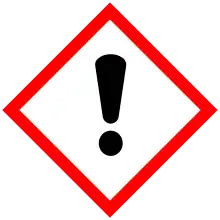 | |
| Names | |
|---|---|
| Preferred IUPAC name
Tridecane[1] | |
| Identifiers | |
3D model (JSmol) |
|
| 1733089 | |
| ChEBI | |
| ChEMBL | |
| ChemSpider | |
| ECHA InfoCard | 100.010.086 |
| EC Number |
|
| KEGG | |
| MeSH | tridecane |
PubChem CID |
|
| RTECS number |
|
| UNII | |
CompTox Dashboard (EPA) |
|
| |
| |
| Properties | |
| C13H28 | |
| Molar mass | 184.367 g·mol−1 |
| Appearance | Colourless liquid |
| Odor | Gasoline-like to odorless |
| Density | 0.756 g mL−1 |
| Melting point | −6 to −4 °C; 21 to 25 °F; 267 to 269 K |
| Boiling point | 232 to 236 °C; 449 to 457 °F; 505 to 509 K |
| log P | 7.331 |
| Vapor pressure | 100 kPa (at 59.4 °C) |
Henry's law constant (kH) |
4.3 nmol Pa−1 kg−1 |
Refractive index (nD) |
1.425 |
| Thermochemistry | |
Heat capacity (C) |
406.89 J K−1 mol−1 |
Std enthalpy of formation (ΔfH⦵298) |
−379.3–−376.1 kJ mol−1 |
Std enthalpy of combustion (ΔcH⦵298) |
−8.7411–−8.7383 MJ mol−1 |
| Hazards | |
| GHS labelling: | |
 | |
| Warning | |
| H315, H319, H335 | |
| P261, P305+P351+P338 | |
| Flash point | 94 °C (201 °F; 367 K) |
| Lethal dose or concentration (LD, LC): | |
LD50 (median dose) |
1.161 g kg−1 (intravenous, mouse) |
| Related compounds | |
Related alkanes |
|
Except where otherwise noted, data are given for materials in their standard state (at 25 °C [77 °F], 100 kPa).
Infobox references | |
Tridecane or n-tridecane is an alkane with the chemical formula CH3(CH2)11CH3. Tridecane is a combustible colourless liquid. In industry, they have no specific value aside from being components of various fuels and solvents. In the research laboratory, tridecane is also used as a distillation chaser.
Natural occurrence
Nymphs of the southern green shield bug produce tridecane as a dispersion/aggregation pheromone, which possibly serves as a defense against predators.[2] It is also the main component of the defensive fluid produced by the stink bug Cosmopepla bimaculata.[3]
See also
References
- ↑ "tridecane – Compound Summary". PubChem Compound. USA: National Center for Biotechnology Information. 16 September 2004. Identification. Retrieved 4 January 2012.
- ↑ Todd, J. W. (1989). "Ecology and behavior of Nezara viridula". Annual Review of Entomology. 34: 273–292(20). doi:10.1146/annurev.en.34.010189.001421.
- ↑ Krall, Brian S.; Bartelt, Robert J.; Lewis, Cara J.; Whitman, Douglas W. (1999). "Chemical Defense in the Stink Bug Cosmopepla bimaculata". Journal of Chemical Ecology. 25 (11): 2477–94(18). doi:10.1023/A:1020822107806.
External links
This article is issued from Wikipedia. The text is licensed under Creative Commons - Attribution - Sharealike. Additional terms may apply for the media files.